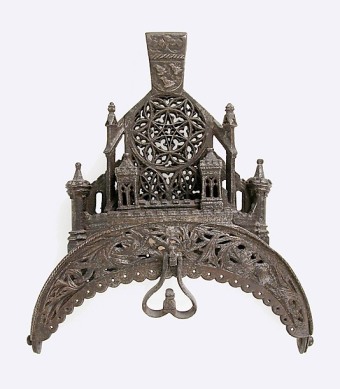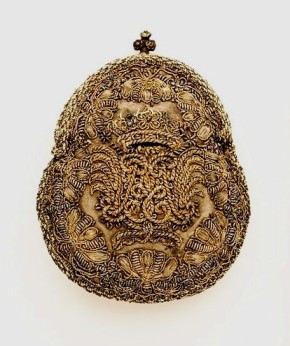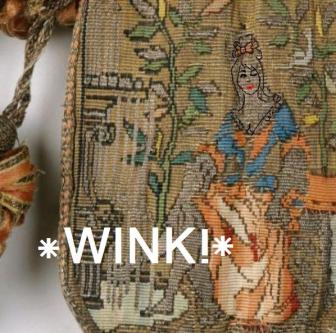18th Century Purses
Let’s face it: girls carry around a ton of stuff. We have combs, keys, credit cards, cell phones, lipstick, band-aids, tissues, pens, and much more crammed into our purses at any given moment. Modern purses come in plenty of shapes, sizes, and materials to hold all our stuff, but what if you’re a modern girl with modern stuff costuming for a historical world? Where can I hide all my now-a-days necessities? The answer is, of course, historical purses! Since I already covered some of the chic purse possibilities for the 15th to 17th centuries, it’s time to cover the fun and filly period between 1700 and 1800!
The first option is pockets. Huzzah for pockets! In the 18th century, they became all the rage. The wide, structured skirts of the period allowed plenty of room for a lady to stash her detash! Pockets are especially handy because they are both hidden and held in place under the skirt, so you don’t have to worry about setting them down and forgetting about them (but do make sure you tie them securely)!
You would never guess how many candied figs you could pocket under this pretty green petticoat without anyone being the wiser! Pockets, whether singles or in pairs, weren’t sewn into clothes like modern ones. 18th century pockets were separate pieces that were worn around a lady’s waist and were accessed through slits in the skirt. Along with an apron and cap, a pocket was an essential piece of every 18th century housewife’s wardrobe. Pockets were almost always decorated, sometimes with just a touch of embroidery or ribbon near the opening, but often full-on blazing with silks or crazy-quilting. They were akin to samplers and were popular items for young ladies to make, showing off their skill with a needle and that they were mature enough to start keeping track of their own possessions.
Pockets not your style? Sometimes they just won’t do and you need something fancier. Most purses during the 18th century were frameless and soft, making them fun to make and decorate. Since they didn’t close with a clasped frame, purses and bags in the 1700s employed a variety of tying and wrapping methods to keep all your widgets from falling out willy-nilly– chasing after chapstick and loose change in a petticoat on a windy day is no picnic!
The first type of purse is a carry-over from the 17th century: the drawstring purse. Bowl-like gaming purses remained popular into the early 1790s, both for men and women (the first purse in this post is a beautiful gaming purse from about 1690-1710). Other drawstring pouches were used as formal wear for parties and court functions. These beaded bags were worn on the wrist or at the waist, so they were very visible and had to look amazing!
If they weren’t filled with a lady’s essentials– scissors, needles, thread, maybe a little packet of rouge if she was a bit of a flirt– these little bags were used as “swete bags,” filled with sweetly perfumed herbs or handkerchiefs to blot out any unsavory smells. Absolutely gorgeous beading became one of the most popular decoration techniques for these small bags. Here’s one covered with courtly motifs like a crown and a pair of cupid-shot hearts:
The small drawstring pouch below was made at the very, very end of the 18th century and was made to match one of those new-fangled ball gowns with the high waists, the beginning of the Regency style. It’s decorated with cut steel beads and gilded filigree spheres.
The next type of purse is the wrap purse, fashionable during the mid-to-late 18th century. Wrap purses function exactly like they sound: you use a long piece of ribbon to wrap your purse shut. These purses are rectangular with a flap that folds over the top.
Pocketbook purses (also called envelope cases) were made in a similar fashion, but didn’t have a wide swathe of ribbon to wind them shut. Some of these purses have button closures, but most merely folded closed.
While wrap purses were considered more feminine and pocketbooks more masculine, both were fairly unisex, depending on the decoration. Wrap and pocketbook purses are very simple to sew and there are so many ways to decorate them!
Floral Embroidery:
Florals are THE motif of the 18th century! Mums, roses, and fruits were the favorites. You can’t go wrong with an 18th century floral.
Beading:
This is a very classy purse from an unusual place. This purse isn’t Italian or French or English, but Mexican/Spanish. The 18th century was the colonial period in Mexico as well as the US. Wealthy Spanish hacienda owners made sure to keep up with Spain’s latest trends, but since they were more isolated than their European sisters, ladies in New Spain put their own twist on European fashions at the time. Spanish colonial is very, well, Spanish: robust, ornate, and often geometric thanks to Moorish influence. All of these mixed cultures make for a very unique wrap purse!
Figural Embroidery:
Figures are tough to embroider, let me tell you! No matter how well you draw or sew, they offer a special challenge. This pretty pastel purse is fantastic! Whoever embroidered it took plenty of time to get it “just right.” Doesn’t it have the perfect amount of charm? Love it!
Ikat-like Flame Stitch Embroidery:
Ikat fabric is made using an ancient resist-dyeing technique on the threads before the fabric is woven. Since the fabric is pre-colored, when it is woven, the pattern is much softer around the edges than a fabric that is printed after it is woven. The watercolor effect of ikat fabric contrasts with it’s other famous quality: bold color and abstract patterns. Ikat fabric became very popular during the 18th century because the exotic patterns really wowed whenever they were draped over the wide panniers and long coats that were all the rage at court. The ikat patterns and colors of the 18th century are much more subdued and natural than modern prints, but look entirely different from the rococo pinks, blues, and yellows associated with the court in the 1700s. If you think this gown is wild:
Can you imagine if it was made of this:
You would stand out, that’s for certain! Since an entire gown made of the expensive, Indian fabric wasn’t an option for most women, bold flame stitch patterns that mimicked the look began popping up in embroidery manuals and accessories everywhere. I find flame stitch embroidery purses almost as often as floral patterns! You can even make Mrs. Manners proud and match your wild purse to your shoes:
Love these shoes!
The final type of purse during the 1700s is the case/chatelaine. Cases are less like purses and more like tailored boxes or jewelry. Most cases were made for wealthy nobles from precious materials. They are specially tailored to hold specific items, usually household tools, tobacco, etc.
This unbelievably fine agate, gold, and diamond case was, reportedly, “a gift from Queen Anne (1702-1714) to Abigail Masham…who was appointed as a personal maid to the queen about 1700” (The V&A Museum). Inside the hardstone shell is the fanciest set of lady’s tools I have seen! The case contains scissors, bodkin needle, fruit knife, and a combined pen and pencil, all made to match (except the scissors which may be a 1750s replacement):
So jealous! No doubt the pencil alone is worth more than a few months of my salary and I’m a writer…oh the irony! Cases are the sisters to chatelaines: pins or clips with watches, pencils, sachets and the like tethered to the top by loops or chains.
Often lavishly bejeweled because they were worn even in court, chatelaines were a purse without a purse. Anything you could possibly need was dangling near your hip within easy reach…no need to fiddle around in the deep, yawning chasm of a tote bag looking for your keys!
Lovely as they are, chatelaines alone aren’t very practical for most costumers since you can’t easily hang your iPhone out in the open and still look like an 1760s gentlewoman, though with some ingenuity you might be able to make a semi-period-looking case for it and all your other small things.
Oh! And one tiny last note about stashing stuff: if you carry a fan, don’t ever tuck in into your purse, bodice, or skirts– worst of all setting it on the shelf of your panniers (although it was quite acceptable to rest your arms on them)! It was considered exceptionally uncouth to carry your fan anywhere but in your hand or dangling from your wrist.
Click here to visit: Where Should I Put It? Part I
For those of us who costume between 1400 and 1700!
As with all my articles, all of the images in this article are either linked to larger versions, articles explaining them, or other fact-filled sites to help you explore, so please feel free to check them out!












































